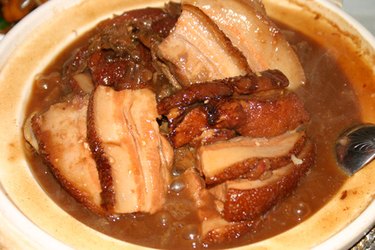Things You'll Need
Pork backfat
Stainless steel, ceramic or stoneware crock
10 lbs. sea or pickling salt
Water
Heavy weight
Platter or other flat object to fit crock

Salt pork is often confused with pork backfat. While both come from the same area of the hog, salt pork is preserved with salt, while backfat is eaten fresh. In days gone by, salt pork was a common ingredient in many meals, since most families kept a hog or two and salt preserving was one of the few ways to keep the meat from spoiling.
Step 1
Cut backfat strips into manageable chunks. Set aside.
Video of the Day
Step 2
Pour 1 lb. of the salt into the bottom of the crock and smooth it to cover. Lay the backfat chunks on the salt.
Step 3
Lay the platter or other flat object over the meat. Add the weight on top to hold the platter in place.
Step 4
Dissolve the remaining salt in 5 gallons of water. Pour over the contents of the crock. Make sure you have enough water to completely cover the backfat and platter. If more is needed, add up to two more gallons of water.
Step 5
Cover and place in cool place, or the bottom of the refrigerator, for two weeks or longer. If extended storage is needed, remove from brine and freeze.
Tip
This is only one way to make salt pork. Many old timers did nothing more than pack the fatback in salt and store it in a wooden barrel in the barn until needed for use.
Salt pork is excellent in cooked green beans and most Southern-style greens recipes. Fatback is generally used in commercial and home cooked pork and beans.
Warning
Check daily to make sure that the salt pork is remaining beneath the brine level and is not exposed to air.
Video of the Day